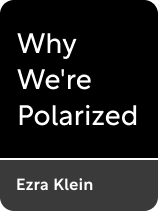

This article is an excerpt from the Shortform book guide to "Why We're Polarized" by Ezra Klein. Shortform has the world's best summaries and analyses of books you should be reading.
Like this article? Sign up for a free trial here.
Do you recognize efforts to sow division between you and your fellow citizens? If so, how do you respond?
In Why We’re Polarized, progressive journalist, political commentator, and podcaster Ezra Klein explores the history and roots of polarization in America and its impact on the two major political parties. Then, he discusses how to reduce political polarization through institutional and individual actions.
Keep reading to find out how Americans might be able to stem the tide of polarization.
How to Reduce Political Polarization
Klein’s advice for how to reduce political polarization includes both institutional and individual approaches. We’ll explore his ideas for how certain institutional reforms can reduce the impact and incentives for polarization, and then we’ll look at how individuals can resist the pull of divisive identity-based political appeals.
Reform Institutions
Klein recommends a set of reforms to American political institutions that he argues will reduce politicians’ incentives to stoke division and resentment by forcing them to compete on a more level playing field. Three reforms Klein proposes to break up this push toward ever-greater polarization are:
- Replacing the Electoral College with a direct popular vote for the presidency
- Creating multi-member districts
- Changing the rules of the US Senate to eliminate the filibuster
Reform #1: Replace the Electoral College
Klein proposes replacing the Electoral College with a direct popular election for the presidency.
According to Klein, the mechanics of the Electoral College create a built-in advantage for low-population, rural, and predominantly white states over high-population, urban, and ethnically diverse states—effectively boosting Republicans while handicapping Democrats. And, Klein writes, in two of the last six presidential elections, the anti-democratic flaws of the Electoral College have resulted in the Republican loser of the popular vote winning the presidency—George W. Bush in 2000 and Donald Trump in 2016.
Klein argues that replacing this system with a direct popular election for the presidency would deny Republicans their automatic advantage in presidential elections and force them to compete on a more level playing field. If they were forced to appeal to a majority of all voters instead of just their partisan base, Republicans would have far less incentive to engage in a polarizing style of politics. Instead, they would be compelled to reach out to and win over more middle-of-the-road voters and voters who don’t already share their ideology.
Reform #2: Create Multi-Member Districts
Another reform Klein proposes is creating multi-member districts, in which more than one candidate can win a seat. This would be a significant departure from the US’s current system of winner-take-all, single-member districts.
Under the current system, each district only has one representative. And because there’s only one seat to be won, voters have a strong incentive to gravitate toward one of the two major parties—instead of voting for a third-party candidate, which would split the vote and allow the rival party to win.
Imagine an election where there’s a right-wing Party A, a center-left Party B, and a further left Party C. If Party A receives 10,000 votes, Party B receives 9,999 votes, and Party C receives 8,000 votes, Party A wins the seat—Party B and Party C get nothing for coming in second and third place, even if they won a combined majority of the votes. Because the two left-wing parties split their votes, the right-wing party wins with a minority of the total vote. Klein writes that this dynamic effectively rewards and reinforces the major parties’ tactics of unending partisan rhetoric and polarization: They know that their voters won’t abandon them or vote third party for fear of throwing the election to the rival party.
The process, however, would be different in a multi-member district, observes Klein. Multi-member districts would reduce the incentive for partisanship and polarization. If, for example, each district had five members—that is, the top five vote-getters earn a seat—voters would have more freedom to vote for the candidate they liked the best, since they wouldn’t have to worry about splitting the vote and inadvertently electing their least-preferred candidate.
Reform #3: Abolish the Filibuster
In addition to replacing the Electoral College and creating multi-member districts, Klein also proposes abolishing the legislative filibuster in the Senate.
The filibuster is a rule in the Senate that requires a bill to get a 60-vote supermajority (a 60% threshold in the 100-member chamber) to end debate on it. It can then go to a final floor vote, where it will then receive a simple majority, up-or-down vote. Unless the majority party wins 60% of the Senate seats (which is increasingly rare in our tightly contested and polarized system) the filibuster gives the minority party the means, motive, and opportunity to frustrate the majority’s agenda by forcing every bill to clear a supermajority threshold. Effectively, the minority party can veto the majority party’s agenda.
Klein writes that the abuse of the filibuster is both a product of the climate of polarization and a contributor to it. The filibuster breeds cynicism among the voters because it makes it impossible for the majority party to govern and implement the agenda it was elected to implement. People become convinced that the majority party is corrupt, dishonest, or incompetent. Voters then typically respond by punishing the majority party at the polls and electing the minority party to replace them—effectively rewarding the minority party for its obstructionism and incentivizing it to engage in similar tactics in the future.
Without a filibuster, argues Klein, legislative majorities would have greater ability to pass legislation and enact their agenda. This would tamp down the voter cynicism and disillusionment that helps foster polarization. Instead, voters would see a greater connection between their votes and actual policies enacted. If voters are pleased with the policies passed by the majority party, they can reward that party at the next election; if they’re displeased, they can vote them out. Klein argues that this is precisely how politics is supposed to work in a healthy, functioning democracy.
Increase Personal Awareness
Aside from institutional reforms, Klein recommends that each of us as individuals can play a role in reducing political polarization.
Since polarizers take advantage of our sense of identity—be it our ethnic, religious, geographic, or economic identity—we can start by being more conscious of how those identities are being manipulated and exploited by cynical political operatives. We can ask ourselves questions like, “Is this politician really concerned about me, or are they trying to activate some sense of tribalism in me?” Once we recognize attempts to manipulate us by appealing to certain parts of our identity, we can more effectively push back against and transcend them.
(Shortform note: Attempts to manipulate our actions by appealing to our core identities can be highly effective. In Influence, Robert Cialdini writes that professional persuaders use a set of common persuasion tactics to get us to comply with them. One of these tactics is based on our openness toward people we see as similar to ourselves—we’re more willing to listen to people with whom we feel we have a common identity, be it religious, ethnic, or anything else. Cialdini writes that we evolved to form a bond with people as soon as we can identify some common ground with them. Knowing this psychological principle, we can see how politicians can skilfully appeal to our shared sense of identity to get us to think, vote, and act how they want us to.)
Finally, Klein also recommends engaging in politics at a more local level. The routine concerns of local politics can often transcend ideological and identity-based grievances and bring different people together. By attending meetings of your local school board or engaging with local civic and nonprofit organizations, you’ll likely find that your neighbors—regardless of their party affiliation—still share the same desires for good roads; quality schools; and clean, honest government.
(Shortform note: In How Democracies Die, Levitsky and Ziblatt write that one strategy to overcome the divisions in our politics is to forge broad, pro-democratic coalitions that cut across the racial, ethnic, religious, and socioeconomic lines that drive our polarization. Such coalitions can be enormously beneficial, they argue. By their very nature and composition, these coalitions can appeal to a broader slice of the country and transcend the partisan divide. This partial defusing of partisan tensions can lead to depolarization, which in turn, strengthens democratic norms of mutual toleration and institutional forbearance.)
Exercise: Overcome Polarization
Klein writes that to overcome polarization, you first have to recognize how politicians are crafting their appeals to activate some part of your identity and get you outraged at some perceived group of “others.”
- Have you ever been confronted by a political message that you felt was targeted toward you because you belonged to some particular identity group? Describe the emotions it evoked.
- Do you feel your political beliefs are based more on a set of ideological or policy preferences, or do you feel your primary political motivation is to defend your community against some group of outsiders? Explain your thinking.
- Do you find it difficult to maintain friendships or personal relationships with people who hold different political beliefs from you? If so, describe why this is the case. If not, describe how you’re able to overcome political disagreement to forge these connections.

———End of Preview———
Like what you just read? Read the rest of the world's best book summary and analysis of Ezra Klein's "Why We're Polarized" at Shortform.
Here's what you'll find in our full Why We're Polarized summary:
- Why bipartisan cooperation is becoming increasingly difficult in the US
- The origins of modern political polarization and its impacts on the parties
- Ideas for how we might depolarize our politics






